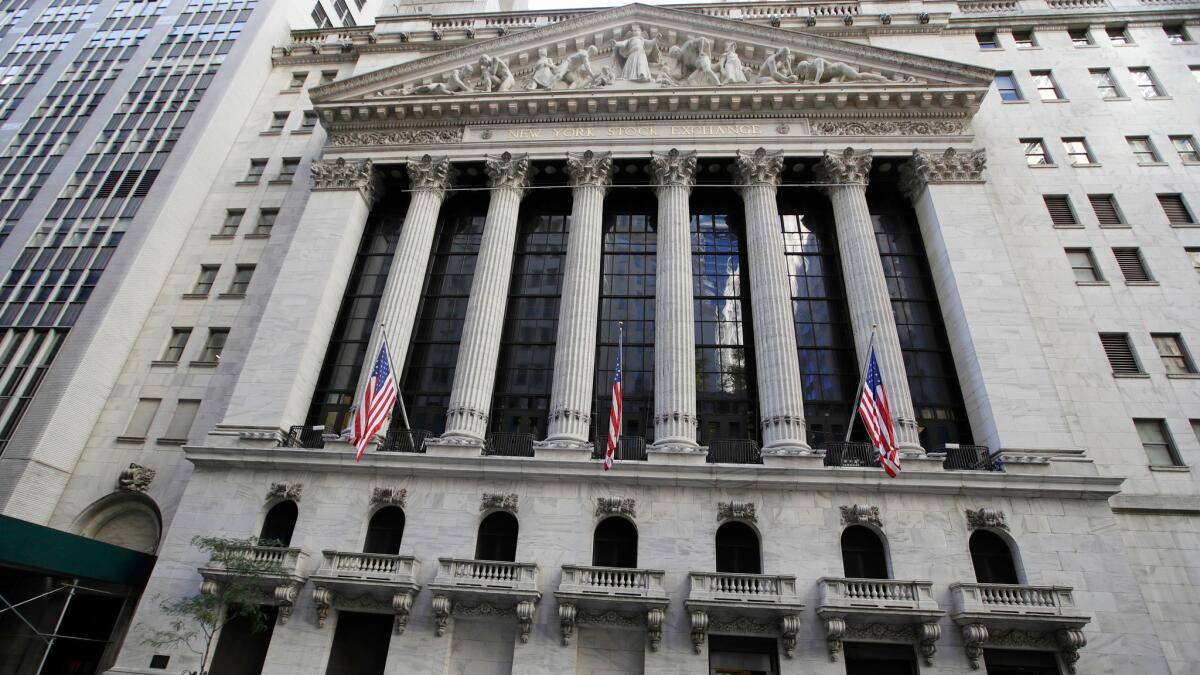Dow erases its 2017 gains as stocks fall and bond yields climb

The Dow Jones industrial average erased its 2017 gains Thursday as it fell for the fifth day in a row, part of a pullback for stock indexes as Treasury yields continued their upward march.
Losses were widespread, with three stocks falling on the New York Stock Exchange for every one that rose. Utilities, real estate investment trusts and others that pay big dividends were among the hardest hit because their payouts look less attractive when bond yields are rising. Small-company stocks took outsize losses.
The Dow fell 72.23 points, or 0.4%, to 19,732.40, slightly lower than where it finished 2016. Still, it’s not far from its record closing high of 19,974.62 set one month ago.
The Standard & Poor’s 500 index slid 8.20 points, or 0.4%, to 2,263.69. The Nasdaq composite declined 15.57 points, or 0.3%, to 5,540.08.
The Russell 2000, which tracks smaller companies, sank 12.81 points, or 0.9%, to 1,345.74. The Russell, which surged after the November election and finished last year with a gain of almost 20%, also turned lower for 2017.
Stocks, which took an electrifying jump higher after the election, have slowed in January as investors wait to see what a Donald Trump presidency will really mean for stocks.
They’ve already seen the optimistic case, as shown in the 6% jump for the S&P 500 after Trump’s surprise election victory, propelled by expectations for lower taxes and less regulation on businesses. But on the possible downside, increased tariffs or trade restrictions could mean drops in profits for big U.S. companies.
“The stock market seems to be perched like a tightrope walker, balanced on the center, but there are a couple hundred-pound weights on each end of the balancing pole,” said Rich Weiss, senior portfolio manager at American Century Investments.
Even with all the uncertainties, the market has remained relatively calm. The S&P 500 hasn’t swung by 1%, either up or down, since early December. And the VIX index, which market pros use to gauge how nervous investors are, is still about 50% lower than where it was a year ago.
Weiss calls that “irrational complacency.”
Bond yields continued their march higher after more economic reports joined the recently growing pile of encouraging data. The 10-year Treasury yield rose to 2.47% from 2.43%.
Yields have generally been climbing since the election on expectations that Trump’s policies will spur more inflation and economic growth.
The 10-year yield is still below its recent high of just over 2.60%, which it reached in mid-December, but it’s also well above the 2.09% level it was at a year ago. Last July it went as low as 1.36%.
One of Thursday’s reports showed that the number of workers seeking unemployment claims fell last week to its lowest level in more than 43 years, a sign corporate layoffs are subsiding. Another report showed that home builders broke ground on more new homes in December, capping a solid 2016 for the industry.
A stronger economy could sway the Federal Reserve to raise interest rates more quickly. The Fed has raised rates twice since 2015 after keeping them at record lows near zero since 2008.
Higher yields may also attract income investors back to bonds and away from high-dividend stocks. That hurts REITs and utilities, which pay some of the biggest dividends among publicly traded companies. Those sectors fell more than the rest of the market.
Banks and energy companies, which climbed after the election, also traded lower.
Industrial stocks were among the few stocks that did well, as railroad operators surged. CSX led the way, leaping 23.4% to $45.51. That was its best day since 1980. An activist investor is reportedly teaming up with the executive who turned around Canadian Pacific Railway to target CSX. Union Pacific rose 2.4%, to $106.24 after it reported stronger fourth-quarter earnings than expected.
Netflix jumped 3.9% to $138.41 after the Los Gatos, Calif., video-streaming service reported higher fourth-quarter earnings than analysts expected and strong subscriber growth.
Read more: Netflix sees dramatic subscriber growth, lifted by overseas expansion »
Oclaro jumped 16.6% to $9.48 after the San Jose optical communications company forecast strong sales in its fiscal second quarter.
The dollar was mixed against its major rivals. It rose to 114.80 Japanese yen from 113.74 yen, and the euro slipped to $1.0659. But the British pound rose to $1.2337 from $1.2284.
Benchmark U.S. crude oil rose 29 cents to $51.37 a barrel. Brent crude, the international standard, rose 24 cents to $54.16 a barrel.
Wholesale gasoline fell 1 cent to $1.53 a gallon, heating oil rose 1 cent to $1.62 a gallon and natural gas rose 7 cents to $3.37 per 1,000 cubic feet.
Gold dropped $10.60 to settle at $1,201.50 an ounce, silver fell 27 cents to $17 an ounce and copper was flat at $2.61 a pound.
The German DAX was virtually flat, the French CAC 40 fell 0.3% and the FTSE 100 lost 0.5% in London. The Japanese Nikkei 225 index rose 0.9%, South Korea’s Kospi rose 0.1% and Hong Kong’s Hang Seng fell 0.2%.
ALSO
Where will Trump begin in slashing Obama-era regulations?
Feds sue nation’s largest student loan servicer, accusing it of cheating borrowers
Steven Mnuchin’s OneWest favored private equity firms, did little small-business lending
UPDATES:
2:40 p.m.: This article was updated with closing prices, context and analyst comment.
8:15 a.m.: This article was updated with market prices and context.
This article was originally published at 7 a.m.
More to Read
Inside the business of entertainment
The Wide Shot brings you news, analysis and insights on everything from streaming wars to production — and what it all means for the future.
You may occasionally receive promotional content from the Los Angeles Times.










